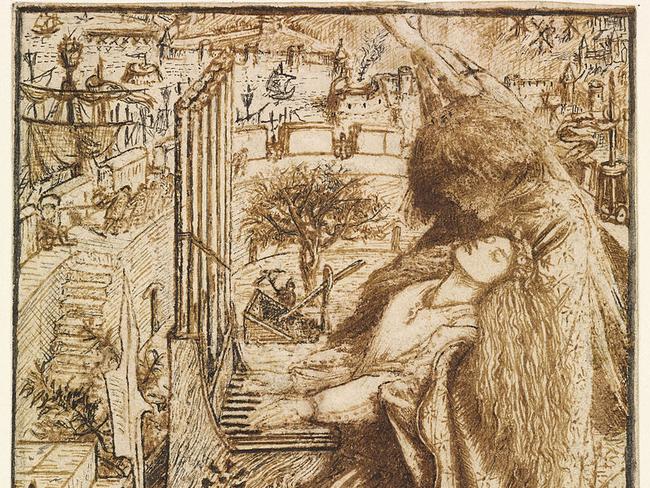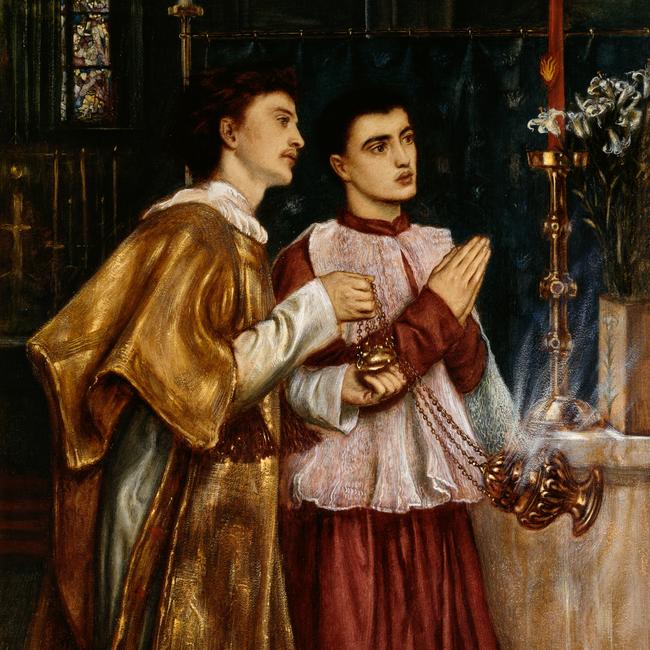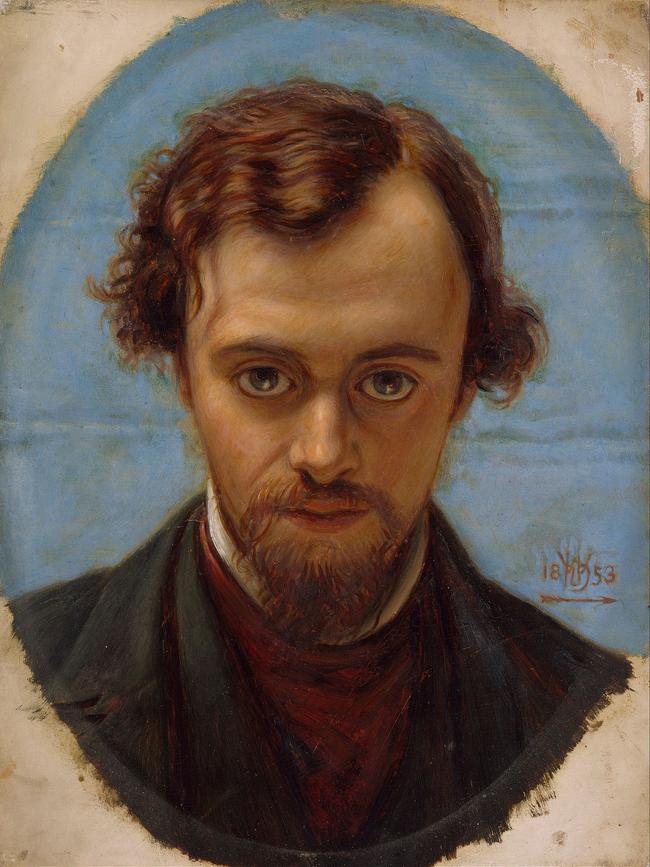The Pre-Raphaelite Brotherhood captured politics, sex and religion
Rossetti, in particular, captured the highly-strung but publicly repressed sexuality of the Victorian age.

The Pre-Raphaelite Brotherhood was one of the first movements in art to set itself up under an appellation of its own choice. Even their German precursors, the Nazarenes, though also consciously established in opposition to academic teaching, did not choose the name that was subsequently attached to them, any more than the Impressionists did in the 1870s.
The choice of name was deliberate and significant. The modern academic tradition, as it had developed in the 17th and 18th centuries and been renewed by the Neoclassical movement, looked to Raphael as its ultimate source of inspiration, although it had absorbed much from the Bolognese and other later masters, too. In England, it was a tradition whose principles had been laid out in Sir Joshua Reynolds’s famous annual Discourses to the newly founded Royal Academy from 1769 to 1791.
To call oneself “pre-Raphaelite” was to appeal to the earlier tradition of renaissance and proto-renaissance art, equivalent to what Vasari called the first two “manners” or styles of modern art: the phase initiated by Giotto at the beginning of the 14th century and the renewed momentum of the 15th century, starting with Masaccio. These early artists were grouped under the title “Italian primitives” and the conscious recourse to pre-classical models can be considered the first example of “primitivism” in modern art, to be followed half a century later by a new interest in archaic Greek sculpture, Romanesque painting and even the artefacts of tribal peoples.

The rediscovery of the early renaissance is a fascinating process that unfolds over the course of the 19th century, when a series of important publications transformed the awareness of the educated public: Jacob Burckhardt’s Civilisation of the renaissance in Italy appeared in 1860, with an English translation in 1878; Walter Pater’s famous essay on Leonardo – which made the Mona Lisa the most famous painting in the world – came out in 1869, and he started the modern cult for Botticelli with an essay in 1870. These and other pieces became The Renaissance in 1873, with an equally influential essay on Giorgione in the 1888 edition; meanwhile John Ruskin’s Mornings in Florence appeared in 1875-76, as the old Grand Tour evolved into a broader middle-class cultural tourism.
But 1848, the year of the formation of the PRB, was also a year of political upheaval all over the European continent: riots overthrew the July Monarchy in Paris, a brief republic suppressed left-wing mobs and then promptly turned into the Second Empire (1852-70); elsewhere, nationalist uprisings in Italy and Germany were suppressed, but foreshadowed the unification of Italy in 1860 and of Germany in 1870.
Britain, the only nation whose liberal political system embraced a constant process of reform and evolution, avoided the violence that broke out elsewhere, but some of the concerns and themes of the time can still be felt, even if more subtly, in the art of the Pre-Raphaelites. There is a general awareness of social questions, common to the Victorian period, and a specific interest in the plight of a working class, as modern industry stripped craftsmen of dignity and turned them into proletarians. This became a particular concern of John Ruskin and William Morris.
There is also a deep fascination with the history of Britain itself, a direct continuation of the romantic rediscovery of local and vernacular cultural traditions, which was particularly marked in places like Germany which had felt excluded from a mainstream dominated during the Enlightenment by France. In the late 18th century, Ossian was admired as a kind of Nordic Homer until he was exposed as a fabrication.
But the corpus of Arthurian legends, renewed through the writings of modern poets such as Lord Tennyson, achieved an unprecedented hold over the 19th century mind, as we can hardly fail to see in this fine collection of drawings from the Ashmolean Museum at Oxford. Arthur himself, Lancelot and Guinevere and countless other more or less connected stories became the staples of serious poems as well as children’s books, before almost disappearing from the literature of the 20th century, immortalised only in the operas of Wagner.
The love of Arthurian subjects was part of a broader interest in the Middle Ages, excluded by renaissance and enlightenment historiographies that emphasised ancient and modern civilisation and considered the intervening centuries, following the fall of Rome, as an age of decline at first and then later of painful recovery. From a romantic perspective, with an interest in the organic life of the “folk”, this medieval period was on the contrary the nursery of authentic British culture.
Fascination with the medieval world was inseparable from nostalgia for the religious sentiment that pervaded the culture of that period. The 19th century was much more drawn to religiosity than the 18th, and yet it was also an age of materialism both in thought and in daily life, and one in which the scientific discoveries of Darwin and others shook the faith of ordinary people as never before. In the enlightenment, one might say, religious belief had ebbed among the educated but was still strong among the masses, while in the 19th century the educated longed for belief and the masses drifted into proletarian indifference.
Some were inspired by deep and passionate faith, but many including John Ruskin himself, though steeped in the culture of the Bible, struggled with the problem of belief in the modern world. Hence perhaps the note of nostalgia already mentioned: and this in turn led back to a world of Christianity that predated the Reformation. This was dangerous territory under the religious laws that prevailed in England from the late 17th to the early 19th centuries, and imposed a range of legal disabilities on anyone who did not recognise the supremacy of the Church of England, including the non-Anglican Protestants known as Dissenters.
Civil disabilities were abolished for Dissenters in 1828 and for Catholics in 1829, meaning that both groups could, among other things, study and teach at Oxford and Cambridge, and it is no surprise that the Oxford Movement, of Anglicans drawn to Rome, began in the 1830s. The most famous member of this movement was John Henry Newman, who eventually joined the Catholic Church as Cardinal Newman.

Anglo-Catholic sympathies are almost inevitably apparent in any works that evoke medieval Christianity, the Holy Family or lives of the saints – all represented in this exhibition – but they are most overt in any images of nuns and convents, which of course had not existed in England since their abolition by Henry VIII. Both Charles Alston Collins’s Convent Thoughts (1851) and Marie Spartali Stillman’s later Cloister Lilies (1891) conjure up pictures of young women contemplating leaving this world for life in enclosed religious communities.
The most celebrated Christian painting by a Pre-Raphaelite artist was undoubtedly William Holman Hunt’s The Light of the World (1854), for which the exhibition includes several sketches and preliminary studies. The sentiment of the work – the sense that each of us should have a personal relationship with Christ – is ostensibly Protestant and was immensely popular at the time, leading the artist to produce two further versions. The original, however, was in the end donated to Keble College, named after a notable member of the Oxford Movement.

Seemingly in contrast with the romantic medievalism and religiosity that characterises much of the work, there was also a rigorous realism that is most evident in the portraits that we encounter at the start of the exhibition. These are generally executed in a precise linear rendering that observes close naturalism and eschews any show of graphic virtuosity. Even modelling is treated minimally and there is no unnecessary use of chiaroscuro – one of the painterly effects that the Pre-Raphaelites particularly shunned. There is a similar closely observed formal and chromatic naturalism in their studies of natural objects, here particularly exemplified by John Ruskin’s remarkable watercolour and gouache study of a crab.
The Pre-Raphaelites were fond of using watercolour and gouache in combination in landscapes, too; there are some beautiful examples here, but while they seem to be pursuing a greater pictorial density, emulating oil painting, they lose the lightness and transparency of true watercolour in the process. A certain dullness results from the subtractive effect of mixing opaque pigments – precisely the sort of effect that Seurat and his followers later sought to avoid.

Women were among the favourite subjects of these artists and one room of the exhibition is devoted to the famous beauties who became models, muses and sometimes artists themselves, in particular Elizabeth Siddal and Jane Morris. The Pre-Raphaelites preferred striking sensual women with strong features and wild heads of hair to the demure type of young lady commonly thought of as the Victorian ideal. The complex sexual relations between these men and their wives or mistresses or indeed those of their friends were certainly far from conventional, although when we look more closely the Victorians were never as straitlaced as we tend to think.
Even so, there is a striking contrast between the way that men and women are portrayed. The lucid clarity of the male portraits, although also to be seen in Dante Gabriel Rossetti’s decisive sketch of Louisa Ruth Herbert (1858), often gives way elsewhere to romantic desire and longing, even in another drawing by the same artist of the same sitter. All too often, sensuality dissolves into plangent and dreamy vagueness, as in Burne-Jones’s portrait of Violet Manners.
The treatment of the figure is even more oddly disembodied and ultimately evasive. The young woman in Collins’s Convent thoughts has no real body under her habit, no physical bulk or weight. At no point in Holman Hunt’s sketches and studies for The Light of the World – from the first scratching quite literally on the back of an envelope – does he conceive of Christ as having a body or consider how the legs bear the weight of the torso. The normal way to work out the posture of a standing figure is to sketch it first as a naked body, where all the articulations of the limbs can be clearly understood. Burne-Jones does this in his study for Pygmalion (c.1875), even if the result is a little fey, but Hunt seems not to want to think about the Saviour having a body at all.

Siddal’s drawing Pippa Passes (1854), illustrating a poem by Browning, is almost excruciatingly awkward in its overly-emphatic gestures supported by no sense of the corporeal reality of the figures. Rossetti’s own drawing of Siddal (c. 1855) turns her into a ghostlike vision. But no work better conveys the introverted imaginative and erotic world of the Pre-Raphaelites than Rossetti’s St Cecilia (1856-57): its lack of clear anatomical articulation makes the image almost completely unintelligible at first sight, while the suffocating level of detail and morbid subject epitomise the highly-strung but publicly repressed sexuality of the Victorian age.
Pre-Raphaelites: Drawings and Watercolours , Art Gallery of Ballarat, until August 6.


To join the conversation, please log in. Don't have an account? Register
Join the conversation, you are commenting as Logout